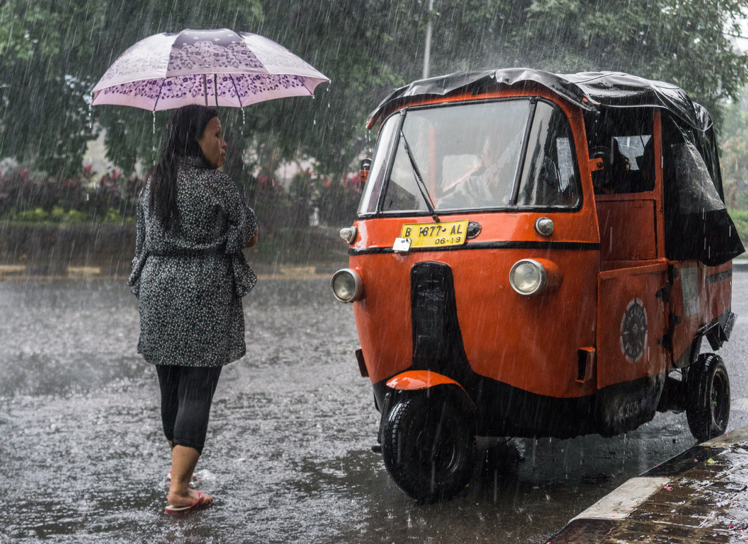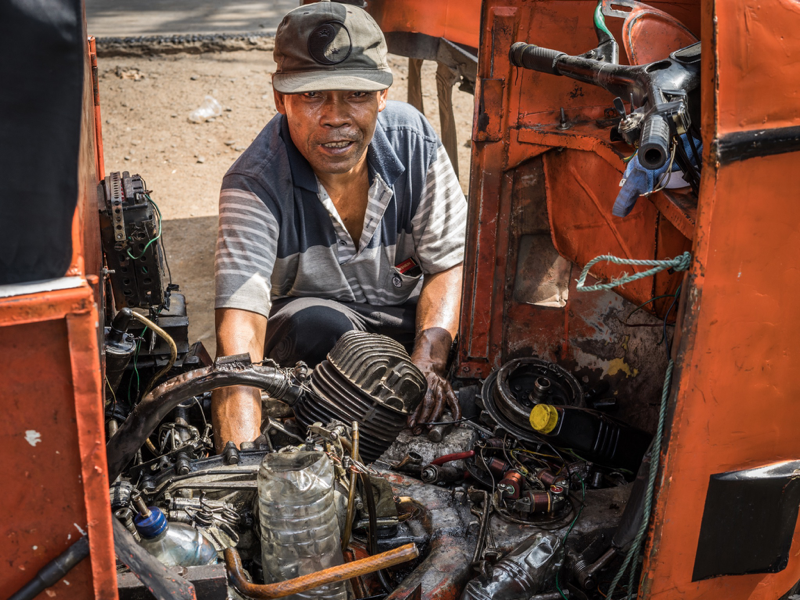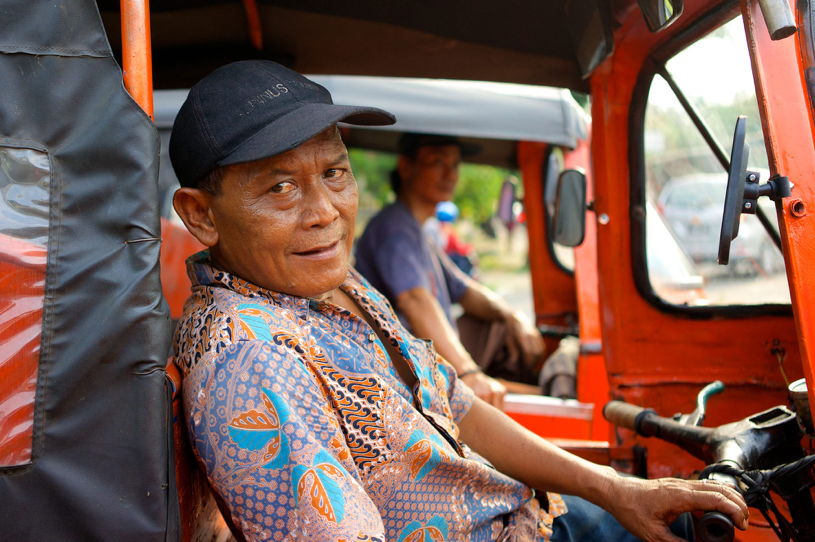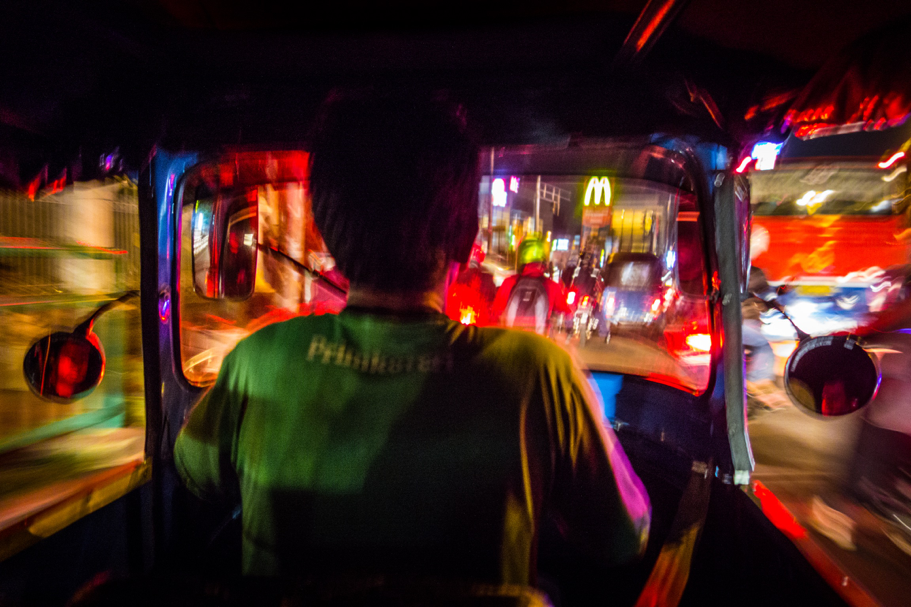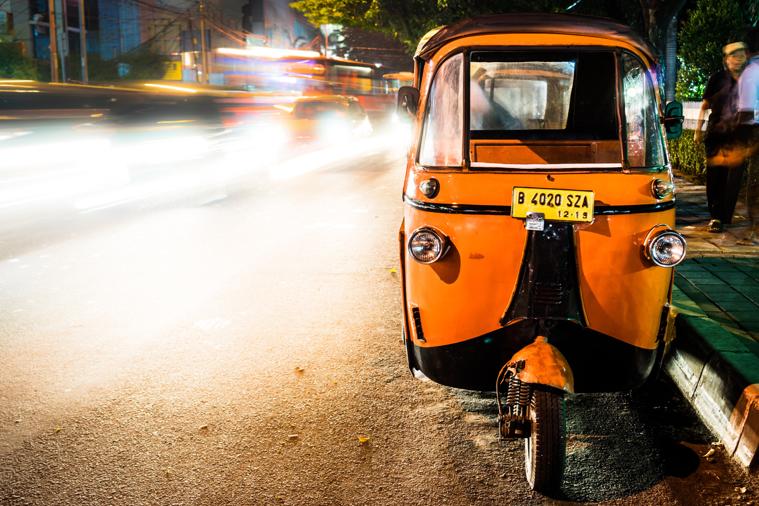Ray Yen reflects on the significance of Jakarta’s iconic orange three-wheeled taxi.
I recently came across a collage of Jakarta’s Blok M terminal, depicting Metro Mini buses and Bajaj in bright orange. This reminds me of something I miss about Jakarta – the orange bajaj (bajaj oranye). Apart from the remarkable progress of various infrastructure projects, the cleaner (main) roads and rivers, and the new footpaths, another visible change in the cityscape since my return is the disappearance of Jakarta’s iconic orange motorised three-wheeled taxi. In 2015, Jakarta’s governor Basuki Tjahaya Purnama (popularly known as Ahok) encouraged orange bajaj owners to switch to the more eco-friendly blue bajaj. Less than two years later, bajaj oranye have all but vanished.
When the orange bajaj still roamed the streets of Jakarta, I wasn’t exactly a fan. Bajaj oranye’s carburetted two-stroke engines produced ear-piercing noises and spluttered clouds of smoke. The ride quality was anywhere between teeth-rattling to bone-shattering. You couldn’t even have a proper conversation due to the noise, or the real possibility of biting your tongue off hitting a pothole.
Despite this, I was oddly drawn to the orange bajaj. To me, they embody a commonly observed quality of Jakarta: a no-nonsense tenacity in the face of adversity. If the bajaj oranye breaks down, no problem – you can easily fix it on the side of the road. Other bajaj drivers are more than happy to chip in. And if you run out of spare parts, you can always pick up something aftermarket in Tanah Abang. The simplicity of its design meant that it wasn’t overly costly for the drivers to maintain as well.
I was also curious about the role of orange bajaj in people’s lives: the experience of an entire family defying the law of physics by cramming into an orange bajaj, middle school kids’ daily routine of riding bajaj oranye to school, the Betawi street performers on their way to the national monument with their giant ondel-ondel effigy strapped to bajaj oranye’s tarpaulin top. Many Jakartans are sentimental about bajaj oranye. You can see this in the common orange bajaj toys, crudely put together by hand with plywood, recycled aluminium cans, and chopsticks. They feature a clever mechanism imitating the crackling noise of bajaj oranye’s two-stroke engines as children pull them along by string. Another common toy is the plastic bajaj oranye bearing a sticker that says ‘angkutan rakyat,’ or ‘the people’s transportation’. This imagery of bajaj was invoked by President Joko Widodo himself in 2014, when he (and Jusuf Kalla) took bajaj to the General Elections Commission (KPU) in running for the top job. This incident was later used by bajaj drivers in a demonstration to Jokowi on the rise of E-hailing services.
As a visitor, I grew to take the orange bajaj for granted. They were an essential part of Jakarta’s streets, and deserved a rightful mention in any encyclopaedia of the city. I was surprised and disappointed to discover they are now gone for good. What’s more, many drivers are now bearing the brunt of such a policy change, and it causes major disruptions to the livelihood of those unable to afford the government-endorsed replacement. Blue bajaj are not only more expensive to purchase, but are also more costly to maintain due to their eco-friendly duo-power-design. This is worsened by the rise of smartphone-based motorbike taxi service like GoJek, GrabBike, and Uber Motor.The passenger base of bajaj was already small due to various access restrictions and generally higher fares. Now there is even less incentive for people to bargain with bajaj drivers on the side of the street, when they could just order a motorcycle taxi on their smartphones for a mere Rp 3000 (30 Australian cents).
To cushion the cost of replacing the orange bajaj, the DKI provincial government is offering credit schemes to owners. “The price of the blue bajaj are just about 50 million rupiahs, just go straight to the bank for credit.” Ahok stated. However, what he didn’t mention is that many drivers don’t own the bajaj themselves.
“I have to pay the owner of the blue bajaj Rp120,000 (A$12) every day. Sometimes when the business is good, I can still get Rp150,000 (A$15) profit after a day’s work. But when it’s quiet, I can’t even break even,” driver Pak Iwan recounted to me. “Many of the other orange bajaj drivers I know lost their jobs because the bajaj owners didn’t consider buying the blue bajaj replacement profitable. Especially when everyone’s using GoJek nowadays.” Pak Iwan doesn’t have another job, nor does he have ‘transferable skills.’ His age makes alternative employment very difficult, if not impossible.
Such challenges are difficult to communicate to people whose lives are distant from bajaj oranye. In a discussion on bajaj drivers’ reluctance to follow government rules due to cost considerations on an online forum popular with Internet-savvy youth, a self-proclaimed political news enthusiast commented: “try checking their identity card.” He is drawing on a popular discourse of the ‘illegality of urban underclass’ – implying that those bajaj drivers who cannot afford to keep up with Jakarta’s progression towards ‘modernity’ are most likely people from rural villages. They do not have Jakarta’s identity cards and are therefore not the Jakarta government’s problem. Another commentator suggested that bajaj should be banned. Like becak (rickshaws) and horse-drawn carriages, they belong to the bygone era and can no longer service Jakarta’s needs for mass transit. Similar attitudes can often be found with regards to the victims of forced eviction.
It’s a bit challenging to not be dismissive toward the tendency to view everything through the lens of legality and efficiency, especially when the same vision is often selectively blurred. But such an outcome is to be expected considering how segregated everyday lives can be in Jakarta. As such, it is counter-productive to moralise at those who grew up stuck in traffic in a Toyota Avanza van behind a smoke-spewing orange bajaj about their lack of appreciation for the ‘angkutan rakyat.’ To the people in Jakarta who grew up riding bajaj oranye, the vehicles are a repertoire of memories; they hold sentimental value which can be difficult to communicate to people who experience the same vehicles from the other side of the windshield. To them, bajaj oranye, like Metro Mini and Kopaja buses, are often associated with the urban ‘not-yet-middle-classes.’ They are an embarrassing reminder of Jakarta’s ‘not-yet-modern-ness.’ Defined by their unruliness, they occupy the ambiguous space between legality and criminality; the drivers frequently disregard traffic regulations and drive like lunatics, they often don’t have proper licences, some of them are underage children who should be at school, and their ramshackle vehicles are responsible for both Jakarta’s appalling air quality and notorious traffic jam.
How can such an experiential dissonance be bridged when the lives of people are ever so segregated at an everyday level? This is perhaps where gradual narrative shifts in popular culture can guide a more fruitful discussion than the blunt force of class-based populist politics. A comedy movie romanticising the everyday experience of a toko sembako, a rock song about the life of a preman (thug), a documentary film giving people a glimpse of what it’s like to be street performers in Jakarta, the collage painting memorialising Metro Mini and orange bajaj at Blok M terminal I saw at an art gallery. Perhaps even a dissertation?
Ray Yen is a PhD candidate at the Coral Bell School of Asia Pacific Affairs, the Australian National University.
 Facebook
Facebook  Twitter
Twitter  Soundcloud
Soundcloud  Youtube
Youtube  Rss
Rss 

